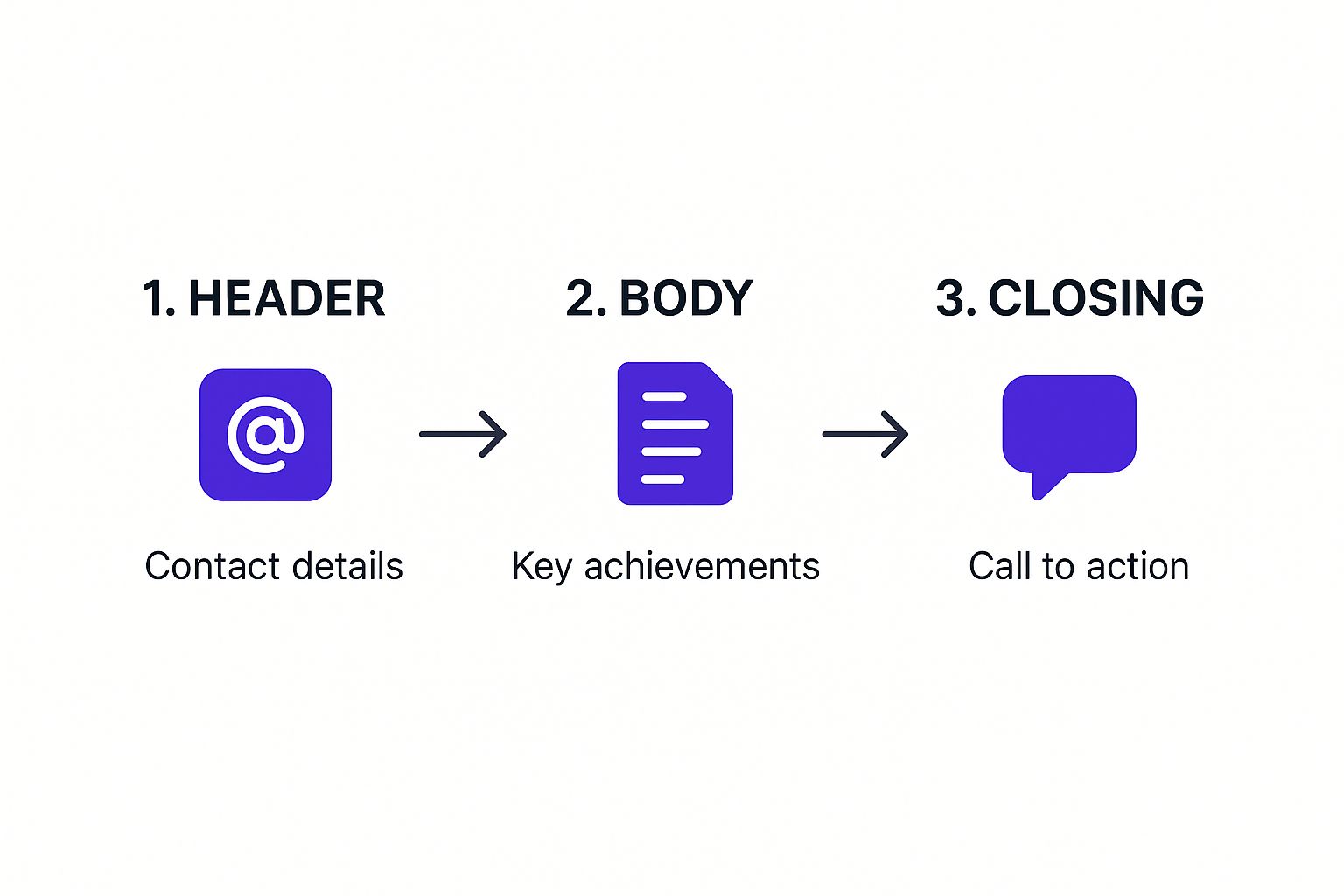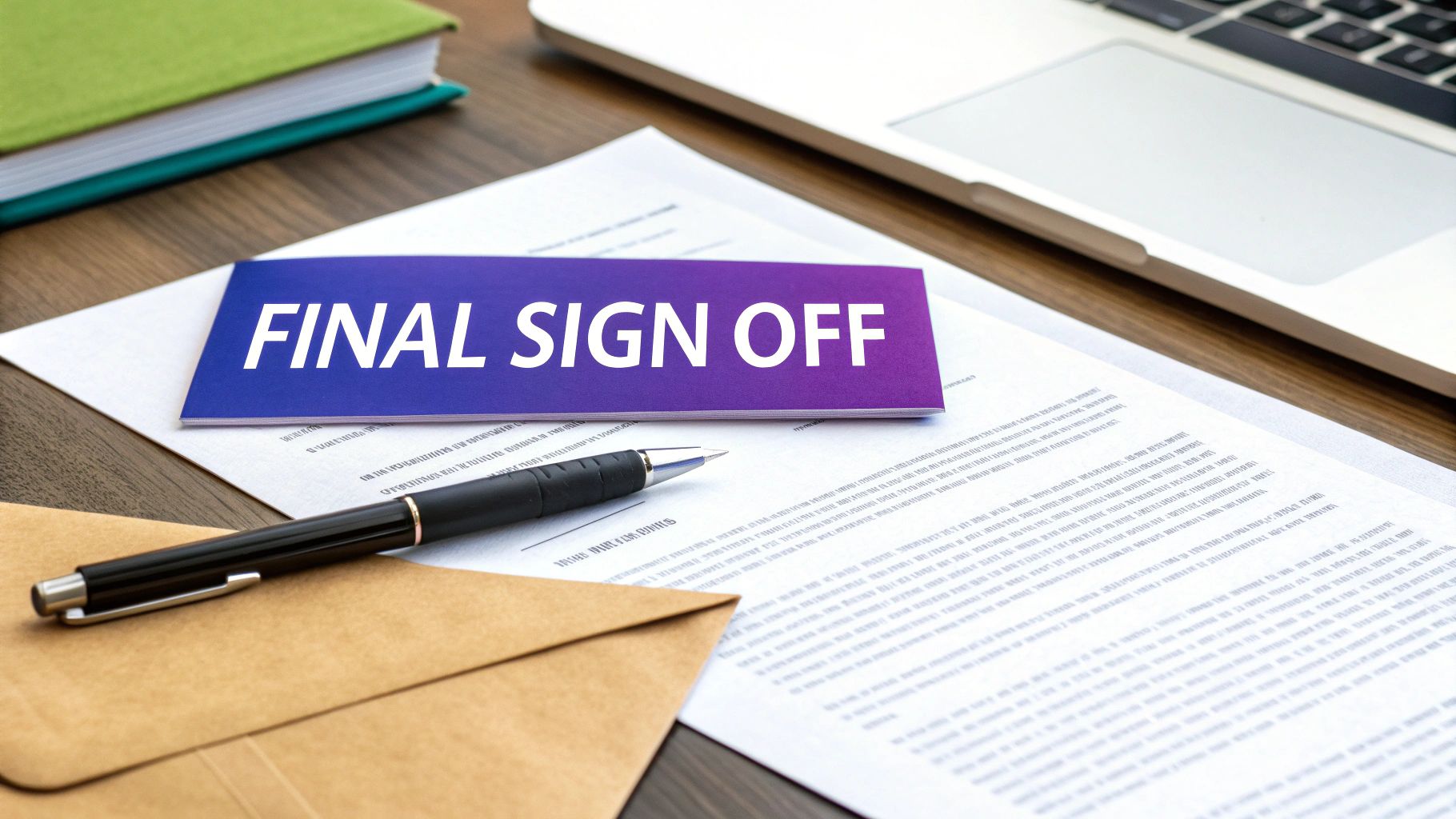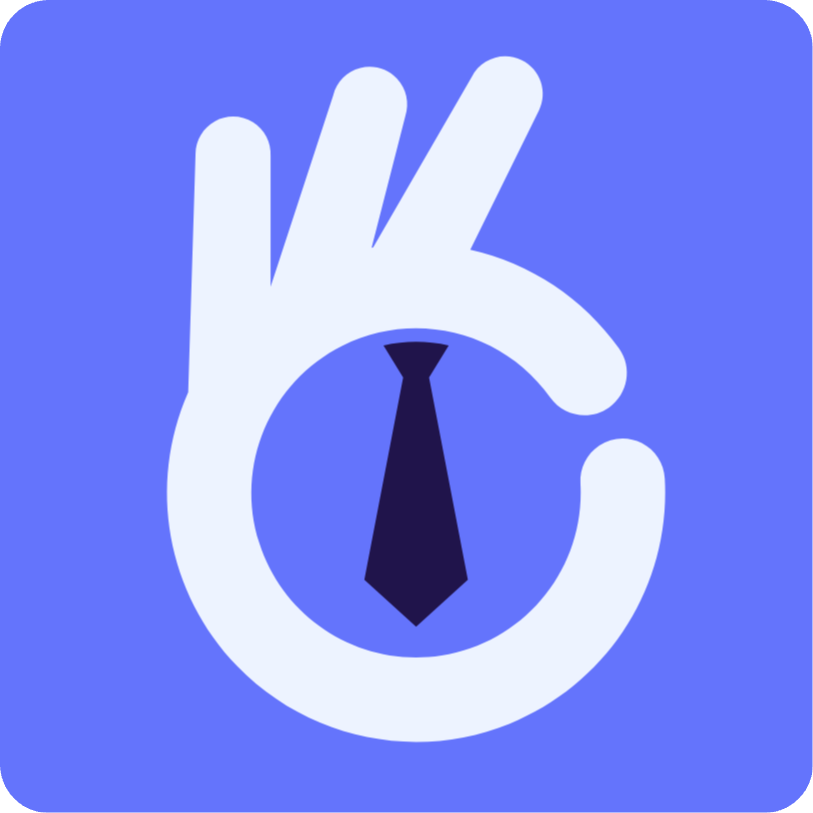How to Write a Cover Letter That Gets Read
A great cover letter isn't just about listing your skills; it's about telling a story. Your story. It’s your one real chance to connect your professional journey directly to what a company needs, showing them you’re the perfect person for the job.
This is where you go beyond the bullet points of your resume and let your personality and genuine excitement for the role shine through.
Why A Great Cover Letter Still Opens Doors
In a world of one-click applications and automated keyword scanners, it's fair to ask: is writing a cover letter even worth it? The answer I’ve seen time and time again is a loud, resounding yes.
A well-written cover letter is still one of the most powerful tools you have. It’s your chance to forge a real, human connection with a hiring manager—something a resume, by itself, simply can’t do.
Think of it like this: your resume is the "what" and the "where." Your cover letter is the "why." It digs deeper to answer the questions that really matter:
- Why are you genuinely interested in this specific company?
- Why are your skills the perfect solution to their unique problems?
- Why should they be excited to get you on a call?
And the data backs this up. Recent studies show that a staggering 87% of hiring managers still read cover letters as part of their evaluation process. That number has stayed surprisingly consistent, even as application methods have evolved. If you're skipping this step, you're missing a huge opportunity to make your case.
The Anatomy of a Winning Cover Letter
Before you start typing, it helps to have a mental map of where you're going. Every part of a cover letter has a job to do, guiding the reader from a strong first impression to a clear, compelling reason to contact you. For a deeper dive, there are some great resources on how to make your cover letter truly stand out and accelerate your job search.
To get you started, here's a quick look at the fundamental building blocks of a cover letter that gets results.
Anatomy of a Winning Cover Letter
This table breaks down the essential parts of a cover letter and their purpose, giving you a quick reference guide before you start writing.
| Component | Core Purpose |
|---|---|
| Header & Salutation | Presents your professional contact info and personally addresses the hiring manager. |
| Powerful Opening | Grabs attention immediately with a strong hook, a key achievement, or a direct connection. |
| Body Paragraphs | Connects your experience directly to the job description, proving you’re the solution. |
| Confident Closing | Restates your interest, summarizes your value, and includes a clear call to action. |
This structure ensures your letter is easy to read and makes a powerful, logical argument for why you should be hired.
A cover letter is your first handshake. It’s where you transform from a list of qualifications into a compelling candidate who understands the company's mission and is ready to contribute from day one.
I know that crafting a truly personalized letter for every single application is a grind. If you want to speed things up without sounding like a robot, our job cover letter generator can help you build a solid first draft to get you started.
Crafting an Opening That Demands Attention
Your opening paragraph is your single best shot at getting a hiring manager to stop scrolling and actually read your application. Let's be honest, they've seen "I am writing to express my interest…" a hundred times today. Your job is to be the one they remember.

This is where that pre-application research really shines. The best openings instantly build a bridge to the company, show you're genuinely excited, and give a sneak peek of the value you’re bringing to the table.
And it’s not just about good manners—hiring managers notice. A surprising 41% of managers consider the introduction the most important part of a cover letter. It sets the tone for everything that follows. You can dive deeper into these cover letter preferences to see what really makes them tick.
Start with a Powerful Hook
Forget stating the obvious (they know you're applying). Jump straight into the why. Lead with a killer achievement, a shared belief, or a direct link to the company's work. This is how you immediately stand out from the stack of generic letters.
Here are a few ways to approach your opening line:
-
The Achievement Hook: Hit them with a number.
- Example: "When I spearheaded the project that boosted user engagement by 30% for a similar app last quarter, I immediately thought of [Company Name]'s mission to build community-focused technology."
-
The Passion Hook: Show you're already a fan.
- Example: "As a long-time user of your project management software, I’ve always admired its intuitive design. When I saw the opening for a UX Designer, I knew I had to apply."
-
The Referral Hook: Name-drop a mutual connection (the right way).
- Example: "My former manager, Jane Doe, raved about your team's culture and encouraged me to reach out about the Marketing Manager role. She felt my experience scaling SaaS startups would be a great fit for your current growth phase."
Personalize Your Salutation
"To Whom It May Concern" is the kiss of death. It’s impersonal and screams that you couldn't be bothered to find out who you're talking to. This tiny detail makes a huge difference.
Pro Tip: Spend five minutes on LinkedIn. Search for the "Head of [Department]" or the hiring manager for that specific team. If you truly hit a dead end, "Dear [Department Name] Hiring Team" is worlds better than a generic greeting.
This small step shows you have initiative. It frames your letter as a direct conversation, not a piece of junk mail. When you're learning how to write a cover letter, nailing this personal touch is a game-changer. It turns your application from just another file in a folder into a compelling handshake with a real person.
Connecting Your Skills to Their Needs
Alright, you’ve hooked them with a strong opening. Now for the main event: the middle paragraphs. This is where you truly make your case. It’s your chance to stop just listing skills from your resume and start proving you're the answer to the company’s problems.
Think of yourself as a detective. Your mission isn't to rattle off every task you've ever done. It's to strategically highlight the wins from your past that line up perfectly with what this role demands.
Find the Employer's Pain Points
First things first, you need to dissect the job description. Go through it with a fine-tooth comb and pull out the top 2-3 most critical requirements. These are the responsibilities they mention first, or the skills that keep popping up. That’s their pain point. That's the fire you need to show you can put out.
Once you’ve identified these core needs, you have your roadmap for the body of your cover letter. Dedicate a paragraph to each one. This keeps your argument focused, powerful, and easy for a busy hiring manager to digest.
The best cover letters don't just say, "I'm a great communicator." They tell a story: "Here's a time my communication skills smoothed over a major client issue and saved the project." That's the difference between telling and showing, and it’s what gets you an interview.
This approach does more than just show off your qualifications. It subtly proves you're an analytical thinker who has already taken the time to understand the company's priorities. You're already thinking like part of the team. Getting these details right is a huge part of learning how to get hired faster.
Use Storytelling to Showcase Your Impact
Now that you know what to talk about, it's time to bring your experience to life. The best way I’ve seen to do this is with a simple storytelling framework called the STAR method. It’s a classic for a reason.
The STAR method turns your accomplishments into mini-stories that are easy to follow and hard to forget:
- Situation: Set the scene. Where were you working and what was the challenge?
- Task: What was your specific mission? What were you responsible for?
- Action: What, specifically, did you do? Use strong, active verbs here.
- Result: What happened because of your actions? This is where you hit them with the numbers—quantify your success whenever possible.
Let’s look at a real-world example. Instead of a bland statement, you can build a narrative.
The Vague Statement (Don't do this):
- "I increased social media engagement at my last job."
The STAR-Powered Story (Do this instead):
- "At my last company (Situation), we were really struggling to connect with a younger audience. I was tasked (Task) with boosting engagement on our Instagram profile. I researched and launched a new user-generated content campaign (Action), which led to a 40% increase in comments and shares and grew our followers by 15% in just three months (Result)."
See the difference? One is a claim, the other is proof. This storytelling approach makes your skills feel real and shows you can deliver tangible results. This is the core engine of a cover letter that works.

This structure isn't just a formula; it’s a logical flow that guides the reader from who you are, to what you've done, to what you'll do for them. It’s how you build a compelling case, one paragraph at a time.
Show You Did Your Homework by Tailoring Your Letter
Let’s be honest: a generic cover letter is the fastest way to get your application tossed in the “no” pile. When you send the same document to dozens of companies, you aren't just saving time—you're screaming a lack of genuine interest.
To truly stand out, you need to prove you’ve done more than just scan the job title. You have to show you're invested in this company and this specific role. Personalization is your secret weapon. It’s what turns a letter that gets skimmed into one that gets a hiring manager excited. This means going way beyond just swapping out the company name.
Go Deeper Than the Job Description
Your research is the bedrock of a truly personalized letter. Before you type a single word, invest a solid 15-20 minutes digging into the company. Look for recent news, product launches, or major projects that catch your eye.
Here’s what you should be looking for:
- Company Values: Hit up their "About Us" page. Do they obsess over innovation, community impact, or sustainability? Find a value that actually resonates with you and connect it to your own story.
- Recent Wins: Did they just land a new round of funding, launch a game-changing product, or win an industry award? Mentioning a recent success shows you're paying attention right now.
- Key Challenges: Read some industry articles about the company. Are they trying to muscle into a new market or fend off a major competitor? This is your chance to frame your skills as the solution they’ve been looking for.
Think of it this way: a great cover letter has a lot in common with a compelling outreach message. Some of the most actionable cold email tips emphasize grabbing attention by showing you understand the recipient's world. That’s exactly what you’re doing here.
Frame Unique Situations as Strengths
Your cover letter is also the perfect place to get ahead of any "unusual" parts of your application. Don't just cross your fingers and hope the hiring manager overlooks a career change or an employment gap. Grab the reins and control the narrative.
- For Career Changers: You have to connect the dots for them. Don't make them guess. Explicitly show how skills from your old field are a perfect match for the new one. A teacher moving into corporate training, for example, should absolutely highlight their expertise in curriculum design and captivating a room.
- For Employment Gaps: Address it briefly and with confidence. Frame it as a period of growth. Maybe you were traveling, learning a new skill, or caring for family. What matters is showing you’re back, re-energized, and ready to hit the ground running.
- For Relocation: State your plan to move and your timeline clearly. Express genuine excitement about the city and the opportunity. You want to reassure them that logistics won't be an issue.
Customization isn't just a "nice-to-have" anymore; it's the bare minimum. A 2023 survey found that a staggering 72% of hiring managers now expect tailored letters. Why? Because it helps them immediately spot serious candidates and get a feel for cultural fit.
Ultimately, tailoring your letter shows respect for the hiring manager's time. It proves you see this opportunity as more than just another job—you see it as a potential partnership. This effort is what transforms your cover letter from a forgettable formality into your most powerful tool of persuasion.
Nailing the Format and Closing with Confidence

You’ve made your case and shown them what you bring to the table. Now it’s time to bring it home.
A strong, confident finish is what separates a pretty good cover letter from a great one. These final touches tell the hiring manager you’re polished, professional, and genuinely serious about the opportunity. Don't just let your letter fizzle out—your final paragraph is one last chance to drive home your enthusiasm and make it incredibly easy for them to say "yes" to an interview.
Craft a Powerful Call to Action
Your closing paragraph needs to be direct and forward-looking. This is not the moment for passive language. You have to clearly state what you want to happen next, which is almost always an interview.
Your goal here is to do three things in quick succession:
- Reiterate your excitement: Briefly mention your genuine interest in the role one last time.
- Summarize your value: Nail down your core contribution in a single, powerful sentence.
- Prompt the next step: Proactively suggest a meeting with a clear call to action.
I see so many people end with a weak line like, "I look forward to hearing from you." Don’t do that. You’re putting the ball entirely in their court. Instead, take control. A much better approach is something like, "I am eager to discuss how my experience in user acquisition can directly contribute to your team's growth targets this year."
For instance, a rock-solid closing sentence could be: "I am confident my project management expertise can deliver similar results for your team and would welcome the chance to discuss my ideas further." See the difference? It shows you're already thinking like a member of their team.
Final Formatting and Presentation
Once the words are perfect, a few simple formatting details ensure your letter is professional and easy to read. Even the best writing can be torpedoed by a sloppy presentation.
And trust me, keeping track of which version of your letter went to which company gets messy fast. This is exactly why a good job search tracker can be a lifesaver.
Here are the essential final touches to get right:
- Professional Closing: Stick with a classic. "Sincerely," "Best regards," or "Kind regards," are all safe, professional choices.
- Your Signature: Type your full name on the line after the closing.
- File Naming: Always save your cover letter as a PDF to lock in the formatting. Use a clean, logical file name like "FirstName-LastName-Cover-Letter-CompanyName.pdf". This small detail makes life so much easier for recruiters and hiring managers.
Common Questions About Writing Cover Letters
Even when you have a solid game plan, a few tricky questions always seem to pop up. Let’s tackle some of the most common ones I hear from job seekers so you can clear those final hurdles and send off your application with confidence.

How Long Should a Cover Letter Be?
The golden rule here? Keep it brief. Your cover letter should absolutely never spill onto a second page.
The sweet spot is between 250 and 400 words. That usually works out to three or four punchy paragraphs that get right to the point. Remember, hiring managers are always short on time. A long, dense letter is an invitation to be skimmed—or worse, ignored completely. Respect their time, and you’ll make a much better impression.
Can I Use AI to Write My Cover Letter?
Yes, but you have to be smart about it. AI tools can be a lifesaver for kicking off a first draft, smashing through writer's block, or just polishing up your sentences. They’re great for getting the basic structure down.
But whatever you do, never just copy and paste what an AI spits out. It will be completely devoid of the genuine personality and specific stories that actually win people over. Trust me, any experienced recruiter can spot a generic, robotic letter from a mile away.
Think of AI as your assistant, not your ghostwriter. Let it build the frame, but you have to be the one to hang the art. It’s your job to inject your personality, your unique experiences, and your real enthusiasm for the role.
AI can also be a handy tool for brainstorming quick answers to those pesky application questions. If you want to see how this works in practice, you can try out a dedicated tool like this job app answer generator to help speed things up.
What if I Cannot Find the Hiring Manager's Name?
This is a classic problem, but resorting to "To Whom It May Concern" is a move of last resort. It just feels stuffy and impersonal. Before you throw in the towel, spend a few minutes on LinkedIn. Search for titles like "Marketing Director at [Company Name]" or "Hiring Manager" for that specific company.
If you genuinely come up empty-handed after a quick search, don't sweat it. You have better options:
- Dear [Department Name] Hiring Team (e.g., "Dear Customer Success Hiring Team")
- Dear Hiring Manager for the [Job Title] Role
- Dear [Company Name] Team
Any of these are worlds better than the generic alternative. They show you at least put in the effort to target your letter.
How Do I Address an Employment Gap?
Your cover letter is the perfect place to get ahead of this. Don't try to hide an employment gap—frame it. A short, confident explanation is all you need.
For instance, you might say something like, "After taking a year to deepen my web development skills through several freelance projects, I’m excited to bring my updated expertise back to a full-time team." Or, "Following a planned career break to focus on my family, I am re-energized and eager to apply my project management experience to a new challenge."
The key is to present the time off as a period of intentional growth or activity, not just dead time. That honesty builds trust and shows you’re a focused professional who is ready for what's next. If you’re navigating the freelance world, you might also find specific guides on how to write a cover letter for an Upwork proposal helpful.
 Interview Sidekick
Interview Sidekick